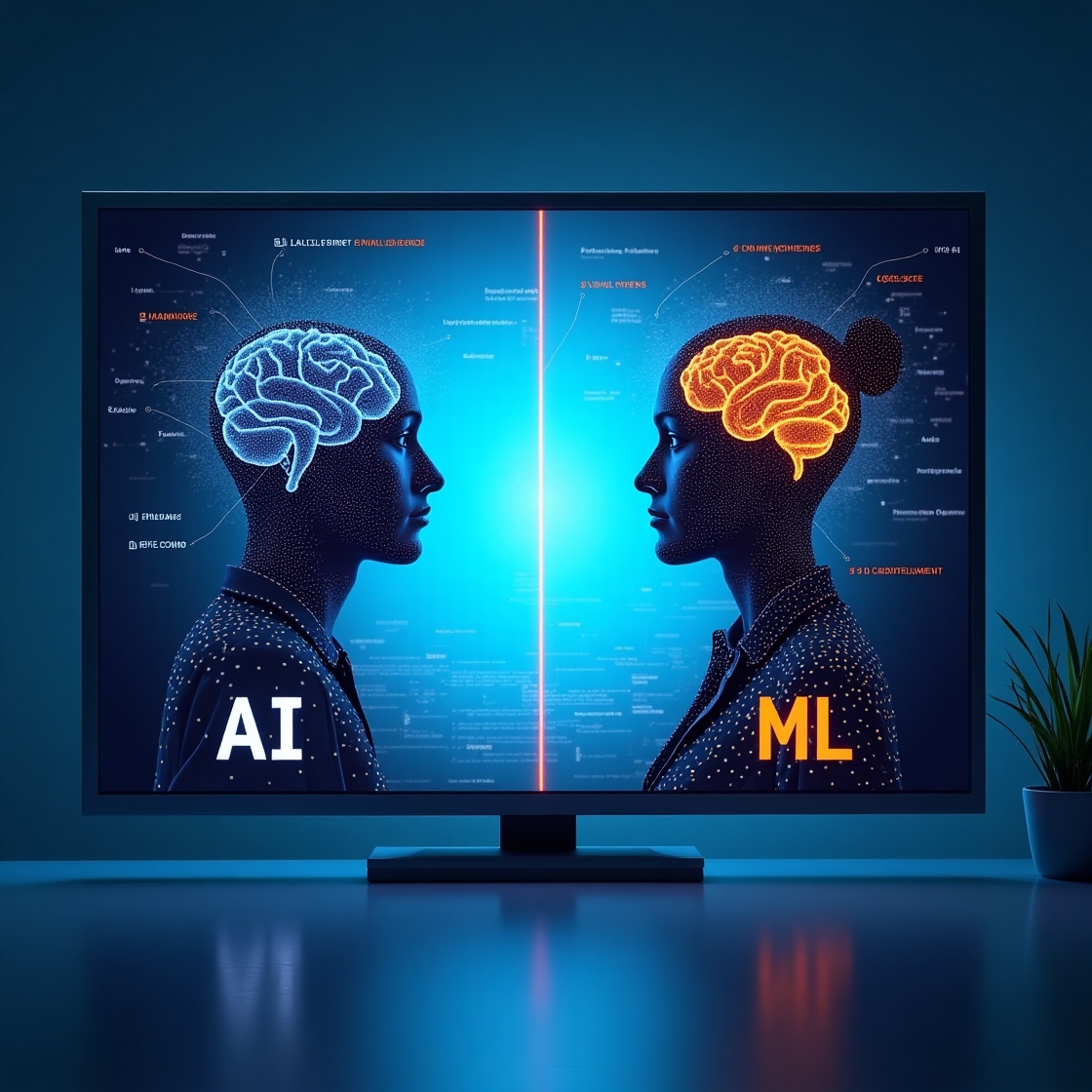In today’s fast-evolving tech world, terms like Artificial Intelligence (AI) and Machine Learning (ML) are often used interchangeably. However, they are not the same. While both are closely related and intertwined, there are critical differences in their goals, applications, and methodologies.
This article will explore the real difference between AI and Machine Learning, how they function, their use cases, and what sets them apart in today’s data-driven world.
Table of Contents
- What is Artificial Intelligence?
- What is Machine Learning?
- Key Differences Between AI and Machine Learning
- How AI and ML Work Together
- Real-World Applications of AI and ML
- Future of AI and Machine Learning
- Final Thoughts

1. What is Artificial Intelligence?
Artificial Intelligence (AI) is a broad field of computer science focused on building smart machines capable of mimicking human intelligence. AI aims to create systems that can think, reason, learn, and even exhibit emotions—much like humans.
Key Features of AI:
- Decision Making: Ability to make autonomous decisions.
- Problem Solving: AI can solve complex problems using algorithms.
- Natural Language Processing (NLP): Interpreting and generating human language.
- Perception: Recognizing images, sounds, and objects.
- Robotics: Controlling machines in physical environments.
Example:
AI powers voice assistants like Siri and Alexa, self-driving cars, recommendation systems, and even medical diagnosis tools.
2. What is Machine Learning?
Machine Learning (ML) is a subset of AI that focuses on enabling systems to learn from data and improve over time without being explicitly programmed. Instead of hard-coding rules, ML algorithms identify patterns in data and make predictions or decisions.
Key Features of ML:
- Data-Driven: Relies on large datasets to train models.
- Self-Improving: Gets better with more data and time.
- Predictive Analysis: Forecasting outcomes based on past trends.
- Classification and Regression: Common tasks in ML.
Types of Machine Learning:
- Supervised Learning – Labeled data (e.g., spam detection).
- Unsupervised Learning – No labels; discovering hidden patterns (e.g., customer segmentation).
- Reinforcement Learning – Learning via rewards and penalties (e.g., game AI).
3. Key Differences Between AI and Machine Learning
Let’s break down the AI vs Machine Learning debate by comparing them across multiple parameters.
| Feature | Artificial Intelligence (AI) | Machine Learning (ML) |
|---|---|---|
| Definition | Intelligence displayed by machines | Learning from data without explicit programming |
| Goal | Simulate human intelligence | Enable machines to learn from data |
| Approach | Decision trees, logic, rules | Statistical models, algorithms |
| Flexibility | Broader concept | Narrow focus |
| Dependency | Not always dependent on data | Heavily reliant on data |
| Examples | Chatbots, robots, autonomous vehicles | Netflix recommendations, email spam filters |
Summary:
AI is the umbrella term, and Machine Learning is one of the methods used to achieve AI. You can think of ML as the “engine” that powers many AI applications.
4. How AI and ML Work Together
Even though they are distinct, AI and ML often complement each other. Here’s how:
- ML as a Tool for AI: Many AI applications use ML algorithms to process data and improve performance over time.
- Feedback Loops: AI systems use feedback from the environment, analyzed by ML, to adapt behaviors.
- Example: A self-driving car (AI) uses machine learning to recognize traffic signs and predict pedestrian movements.
AI provides the goal (intelligence), and ML provides the methods (learning) to reach that goal.
5. Real-World Applications of AI and ML
1. Healthcare
- AI: Disease diagnosis, robotic surgeries.
- ML: Predictive analytics for patient outcomes.
2. Finance
- AI: Fraud detection systems.
- ML: Algorithmic trading, credit scoring.
3. Retail and E-commerce
- AI: Virtual shopping assistants, chatbots.
- ML: Personalized product recommendations.
4. Marketing
- AI: Ad targeting, customer segmentation.
- ML: Predicting customer lifetime value (CLV).
5. Transportation
- AI: Self-driving technology.
- ML: Traffic pattern analysis, route optimization.
6. Future of AI and Machine Learning
The future of AI and ML is not just promising—it’s transformational. As computing power increases and more data becomes available, the potential for AI-driven innovation grows.
Key Trends to Watch:
- Explainable AI (XAI): Making AI decisions more transparent.
- Edge AI: AI processing directly on devices (IoT, smartphones).
- AutoML: Automating the machine learning pipeline.
- AI Ethics and Bias: Ensuring fair and responsible AI.
Job Market Insight:
As AI and ML continue to evolve, careers in data science, AI engineering, ML research, and AI ethics are seeing massive growth.
7. Final Thoughts
So, what’s the real difference between AI and Machine Learning?
- AI is the broader concept that aims to simulate human intelligence.
- ML is a subset of AI focused on enabling machines to learn from data.
Understanding this distinction helps individuals, businesses, and developers make better decisions about how to use these powerful technologies effectively.
Whether you’re a student, a tech enthusiast, or a business owner, grasping the difference between AI and ML is crucial for staying ahead in the digital age.


